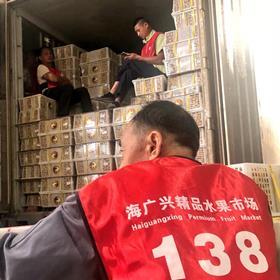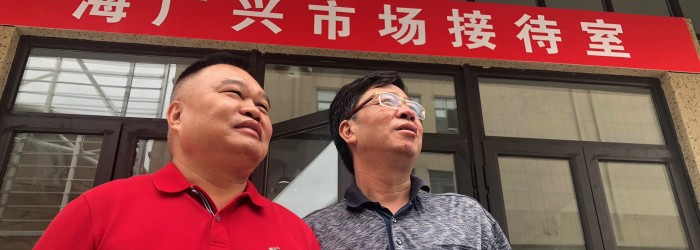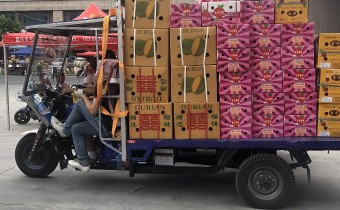
The Jiaxing Haiguangxing Premium Fruit Market (JHPFM) opened this week. The new market west of Shanghai is a cross-country collaboration between the heads of China’s top two markets for imported fruits in Shanghai and Guangzhou, and the manager of Jiaxing Market, the largest domestic wholesale fruit market in China handling around 2m tonnes of fruit annually. JHPFM is aiming to become China's largest wholesale market for imported and domestically grown produce. Here, Kurt Huang, GM of customs clearance company Shanghai Oheng Import & Export Co (pictured below), talks exclusively to Fruitnet about the crucial role the market will play in the regional and national import trade.
Can you tell us about the ownership of the market, and how the project came about?
Kurt Huang: This project is a joint investment by mainly three influential people in China’s fruit wholesale market business: Xu Zheng, who was the general manager of Shanghai Longwu Market from 2003 to 2013, then general manager of Shanghai Huizhan Market from 2013 to 2017 (left of letterbox image below); Zheng Nansheng, the general manager of Guangzhou Jiangnan market (right of picture below); and You Zhijiang, the general manager of Jiaxing Fruit Market. You is the new market’s chairman, and Xu is the general manager of the JHPFM.
JH: When did JHPFM officially open for business? What level of trade support does the market have?
KH: It opened on 10 September on a trial basis. There was no official opening ceremony; business was just simply transferred from the old market to the new one, so the new market was busy immediately. The Jiaxing Haiguangxing Premium Fruit Market lies adjacent to Jiaxing Fruit Market, which was already well established since the early 1990s as a key wholesale and distribution centre for domestically grown fruit in China.
There are over 100 companies signed up to operate from the new market; all booths are leased. Companies include all the major wholesalers in East China, as well as some from other areas.
Having a new market in Jiaxing gives newcomers the opportunity to start a business, otherwise it would have been impossible for them to enter the wholesale business in this area (no space). So, companies are currently busy setting up their new sales team in Jiaxing, decorating their offices.
What kind of products will the market be handling and from where? Will it be primarily for imported fruits, or for domestically grown fruits too?
KH: This market is called a ‘premium’ fruit market rather than an ‘imported’ fruit market, because now premium-quality domestically-grown fruits are sold there, together with imported produce.

We understand JHPFM is located 100km west of Shanghai. What kind of geographic area will the market serve in terms of sourcing and distribution? Can you explain its strategic location in terms of serving eastern China?
KH: Shanghai was the main market for imported fruits in the past, but now the surrounding area consumes more as the population of Zhejiang and Jiangsu together has a population of around 130m, while Shanghai has 30m inhabitants. So it will be more convenient for companies to buy from Jiaxing instead of Shanghai.
Shanghai will act as a main port of entry for the region, and a market for itself. Meanwhile, Jiaxing is located in the centre of the highway network, so it’s ideally located as a regional distribution centre for imported fruit – a role it already fulfilled for domestic fruits.

Consumption of imported fruits in China has been dominated by East Coast cities to date, but demand is growing from fast-emerging second and third tier cities in the interior. What role will JHPFM play in extending the distribution of imported fruits into these cities?
KH: The previous Jiaxing fruit market covered an area with radius of 600km, so Haiguangxing will possibly reach the same distance. In the future, it might even have an equal reach to the Guangzhou Jiangnan market.
What will the opening of JHPFM mean for existing Huizhan wholesale market in Shanghai?
KH: We think the market is big enough for both Jiaxing and Shanghai to exist, but play different roles: Shanghai for Shanghai, and Jiaxing for East China. Jiaxing is a more traditional market, so it needs more a traditional wholesale market. Wholesale markets in Shanghai will play less important roles in the near future as the retail network in Shanghai is much more established, so it will turn to a DC system with its own overseas sourcing. Wholesale market sourcing will became supplementary.
Guangzhou Jiangnan market is a much bigger wholesale market than Huizhan in Shanghai, handling almost triple the volume. How do you see the opening of JHPFM changing the landscape of the business?
KH: Guangzhou Jiangnan market moves roughly around 65,000-70,000 containers while Shanghai handles around 25-30,000 containers, including direct arrivals by sea and tropical fruit by truck. Jiagnan’s main advantage in the early years was its position as an entrepot for fruit entering via Hong Kong, given the lack of legal access for direct imports. It has become the national centre with buyers coming from inland markets while Shanghai’s role is only regional distribution. Plus, with Hong Kong being the gateway for southern China, the transit times are shorter than northern ports.
While Shanghai is a regional centre, now the demand from the surrounding area is bigger, so the distribution hub needs to move inland. Jiaxing has been moving greater volumes of tropical fruits than Shanghai for several years, but has been relatively weak in western fruit imports.
Jiaxing is not just a new market: it signals a strategic change for the whole east China region, or even the whole business. The volume between Guangzhou and east China will become more balanced in the future.


What capacity does the new market have and what facilities does it include?
KH: The new market has a processing area of around 1,000m2; office space of around 20,000m2; and a cold storage capacity of around 20,000m2. The total market area covers around 166,500m2.
What kind of buyers do you expect to visit the market and where from? What advantages will they find compared with visiting other markets, such as Shanghai or Guangzhou?
KH: Buyers will include big wholesalers from surrounding cities in East China, and retail chain stores, online vendors and so on. Some retail chains are setting up their East China distribution centres in Jiaxing now. Offering imported as well as domestic fruits, the new market offers buyers one-stop sourcing, with lower costs.
What tie-ups or relationships does the new market have with logistics and port operators to facilitate swift and efficient movement of imported produce?
KH: The Chinese government is simplifying the clearance procedure. Now imported fruits don’t need to be inspected one by one, it’s random. Only around 30 per cent of shipments will be opened for inspection, the rest can go directly with the container seal intact. And for those that need to be inspected, it can be done at the port site, while before, inspections had to be carried out in appointed sites in several wholesale markets. So the clearance will be more efficient, and go to Jiaxing directly from the port. Jiaxing can use both Shanghai and Ningbo ports, the two largest ports in the world.
How would you summarise the main opportunities and challenges facing JHPFM?
KH: More space offers more growth potential. This will happen in Jiaxing Haiguangxing: every player will see individual growth, thereby increasing the total market size. The whole area will be totally independent, meaning no more dependence on the Guangzhou market; the two markets will be on a par with one another.






No comments yet